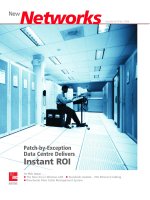Tài liệu Network News - Vol.12 No.4 docx
Bạn đang xem bản rút gọn của tài liệu. Xem và tải ngay bản đầy đủ của tài liệu tại đây (2.89 MB, 16 trang )
Vol12 No4 2005
Vol12 No4 2005
In this issue . . .
■■
Global Rush Toward IP Services Delivery
■■
ADC KRONE's New Fibre Solutions System
■■
FOXTEL Selects CopperTen
™
for Its New Sydney Headquarters
®
I
t’s my pleasure to share with you ADC’s third
quarter earnings results. The company had very
strong financial and business results once again
this quarter, the highlight being a 40% year-on-
year increase in sales. Similar to our second fiscal
quarter results, we continued in the third fiscal
quarter to deliver among the strongest year-on-
year growth in sales and earnings per share when
compared to most other communications
equipment suppliers.
Our breaking global news is that in August, we
acquired Fiber Optic Network Solutions (FONS)
Corp., a leading manufacturer of high-performance
passive optical components and fibre optic cable
packaging, distribution and connectivity
solutions. FONS is based in Massachusetts, USA.
With the addition of FONS, ADC is now one of
the largest suppliers of Fibre-to-the-X (FTTX)
solutions, according to proprietary market share
estimates. FONS has strategic partnerships and
outsourcing relationships in many countries
including Japan, China and the Americas.
With this acquisition, we can more fully
leverage our strengths to deliver on customer
demands for fibre in the central office, the
outside plant and at the customer premises. With
fibre being an increasing area of interest in the
Asia Pacific region, this will assist us in bringing
our customers the very best range of fibre
solutions.
In the last edition of Network News, we told
you about the FiberGuide
®
product, a new
addition to our TrueNet
®
portfolio. This edition,
Alan Crawford details the FL2000 fibre panels -
another fibre solution you might like to consider.
See page eight for details.
For our readers who are IT Managers,
I encourage you to take a look at Tim Takala’s
article on page four. Tim highlights some keys to
help you diagnose the source of issues within
your network based on a few common symptoms.
Cisco Networkers, held in September was a
great success and an event we value as a Cisco
Partner. It’s always a great opportunity for us to
touch base with our customers and update you
on the latest developments in our TrueNet
solutions.
With this being the last edition of Network
News for the year, I’d like to take this opportunity
to thank you for your continued support. We look
forward to serving you in 2006 with innovative
products from our expanding global portfolio and
continue to focus on meeting your customer
service needs.
Sincerely,
Bob Fitzgerald
2 ❙ NETWORKnews
A NOTE FROM BOB FITZGERALD
ADC KRONE News
8 FL2000 Fibre Solutions System
Technical Articles
3 Global Rush Toward IP Services
Delivery
4 It's the Duplex Stupid!
12 Proposed Method of Testing
Fibre Links
Customer Stories
7 Club KRONE Customer
Testimonial
10 FOXTEL Selects CopperTen for its
New Sydney Headquarters
14 TERMINATOR Gets Smart
15 TERMINATOR Turns up the Heat
Editor: Sarah Bishop
Art Direction: Nora Collins
Website: adckrone.com/au
CONTENTS
Copyright © 2001 KRONE Australia Holdings Pty. Limited
C
arriers and Enterprises are aggressively
deploying voice, data and video services
based on IP Infrastructures. Advocates believe the
move towards converged networks and the IP-
based circuitry that underpins them will enable a
host of applications that will be available to end
users on a wide range of fixed and portable
electronic devices.
This change will not happen overnight. Current
circuit-based networks must be transformed into
packet-based networks and in many cases
completely new infrastructure builds are
underway. However, when it is completed,
carriers, infrastructure providers and application
developers agree that the move towards of IP-
based networks will represent a seismic shift in
the telecoms landscape.
IP-based networks represent a fundamental
change of the telecommunications infrastructure
because its adoption involves taking apart the
vertically integrated elements of traditional circuit
switched networks. From a network engineering
perspective, this new structure is typically described
as consisting of three horizontal layers: a
technology agnostic ‘infrastructure layer’, a
‘switching and routing layer’ and an ‘application
layer’.
The intent of IP-based networks is to provide
the unifying platform that enables network
convergence, allows rapid deployment of new
services and, because they are based on open
standards, keep costs down.
To deliver the complete mix of IP-based
services, every carrier must evolve all areas of the
services delivery - Wireless Services, Residential
Services and Business Services. Carriers are rolling
out initiatives in four areas to enable the new IP
services:
■
Circuit to Packet infrastructure migration in
the network core
■
Deep Fibre using Fibre-to-the-X (Node, Curb,
Premises) for delivery of broadband services
■
Wireless IP-based networks for advanced
data and video services
■
IP-based high speed business services delivery
Given the future impact of these Carrier
infrastructure initiatives, Enterprises need to take
a close look at their requirements to leverage the
carriers’ new IP-based networks. There are many
reasons for this. Medical imaging and file data
transfer is increasingly growing. Network storage
is becoming increasingly critical. Grid & cluster
computing is gaining adoption in public and
private sectors, and we are seeing an increase in
next generation enterprise applications such as
RFID, IP Factory networks and Intelligent
Buildings. As a result of these changes, more
throughput and signal integrity will be required.
With 10-Gigabit Ethernet over copper coming to
routers/switches in 2006, end-users again have
the opportunity to prepare themselves for their
future needs.
■
NETWORKnews ❙ 3
GLOBAL RUSH TOWARD IP SERVICES
DELIVERY
Why Enterprises need to look at the developments in the
telecommunications space to prepare themselves for the future.
Carsten Quiram,
Marketing Director,
Asia Pacific
Wireless Services
Residential Services Business and Enterprise Services
Every service provider and enterprise must evolve all areas of the network to deliver a new mix of IP-based services.
N
othing they teach you in a textbook can
replace experience from the field. The same
thing also holds true for the saying “Mechanics
are only as good as their tools”. If there’s one
thing time has taught me from the field it’s that
the only constant is change.
There was a time when the only way a
structured cabling manufacturer could
differentiate was to say “my headroom is bigger
than theirs”. That’s when everything was based
on dB values. Then came claimed frequency
range, where companies were playing “Name
That Tune” with extended frequency response.
“If you claim you can work to 350MHz, than I’ll
claim 400MHz”...surely this must be better, right?
How confusing for the network administrator.
“Who do I believe? What’s really important? How
do I choose the best solution for the money?
Which vendor is telling me the truth? I just want
my network to be reliable! I don’t talk Megahertz,
I talk Megabits!”
If you want to make an IT guy’s head spin
simply start throwing out acronyms/terms like
PSELFEXT or Attenuation to Crosstalk Ratio. Do
you really want to know whether the cable is
good? The answer is much simpler than you think
and lies in one question. Does the network run at
its full potential?
What is the fundamental task of the network?
It’s the transport and storage of data and has
nothing to do with dB’s of headroom! It’s
important to remember that every network is as
individual as the people supporting it. Networks
are almost human. They’re a living, breathing
series of components transporting data through
veins (cables), working to ensure the business
thrives.
Many years ago, ADC KRONE (then KRONE)
adopted this philosophy and as a result has
gained a great deal of knowledge on what really
matters to the network administrator. Through a
series of excellent networking tools and a good
working knowledge of networking fundamentals,
we started a journey to understand the real
concerns the IT departments faces daily. As a
result, in 1999 ADC KRONE’s ZeBER* was
launched. ZeBER bridged the gap between the
structured cabling manufacturer and network
administrator perspectives. The argument was
taken away from Megahertz and more emphasis
was placed on reliable transmission of Megabits.
Testing was conducted in the field, after the
network was up and running, to ensure data was
flowing throughout the network reliably.
Fortunately the tools we deployed not only told us
how well the cabling infrastructure was working,
they also told us a great deal about the active
components.
There’s a misconception that cabling is
responsible for most of the problems within the
network infrastructure. As the cable guy I’d like
4 ❙ NETWORKnews
IT’S THE DUPLEX STUPID!
Tim Takala unveils some common misconceptions on the causes of
network errors.
Tim Takala, Corporate
Business Manager
It’s important to remember that every
network is as individual as the people
supporting it. Networks are almost human.
They’re a living, breathing series of
components transporting data through
veins (cables), working to ensure the
business thrives.
*With ZeBER= Zero Bit Error Rate. With the related warranty, ADC KRONE guarantees that the physical layer infrastructure will
cause no greater than 10-
12
bit errors per second.
nothing more than to be able to tell you that this
is true, but it’s not. Any good IT guy worth his salt
will see right through this argument and tell you
“it’s the duplex stupid”!
When monitoring a network using SNMP,
several different types of errors can and will be
found, depending on circumstance. CRC’s
(cyclical redundancy check, also known as FCS
errors), fragments, collisions, jabbers, runts,
oversize, misalignments and the list goes on and
on. If the network is a living and breathing entity
than these are the symptoms of sickness. Being
able to diagnose what is causing these symptoms
comes from experience.
Typically when CRC errors are present, from a
textbook perspective, it is due to an issue on the
physical layer i.e. the cabling and connectivity.
This is where the textbook needs to be put down,
where common sense and experience need to
take over. Different types of active hardware from
different vendors will report errors differently.
Remember when I said that the only thing
constant is change. This holds true for active
hardware manufacturers. Not only is different
manufacturer’s equipment designed differently,
equipment from the same manufacturer can also
be very different functions and report errors.
When it comes to CRC errors, what you see on
the surface can be very deceptive. This error type
is the most prevalent within networks and the
reason for the misconception that the cable
causes most errors in networking, but if you look
below the surface you will find a completely
different answer.
Bear in mind that a good cabling infrastructure
is the foundation of the network. Electrical
problems with the cabling can manifest
themselves as errors in the active hardware, but
that’s why we test the cable during installation.
Compliance with cabling standards gives
confidence that the protocols supported will work
with little or no issues. ADC KRONE’s impedance
matching philosophy took this to an even higher
level.
So, why do I have CRC errors if the cable is of
a good quality? First you need to understand
what a CRC error actually is. Imagine that each
packet of information you are transmitting on a
network is a letter. It has a source address, and a
destination address, contains information and it
NETWORKnews ❙ 5
What is the fundamental task
of the network? It’s the
transport and storage of
data and has nothing to do
with dB’s of headroom!
also has a built-in spell check - CRC. When the
letter reaches its destination the recipient checks
the packet to ensure that the spelling (CRC) is
correct. If a single bit is out of place the
letter/packet is rejected and needs to be sent
again, hence an error has occurred. While the
cabling can cause bits within a packet to become
corrupted, typically the cause is from a different
source. ADC KRONE’s TrueNet
®
portfolio cabling
will ensure this holds true.
Active hardware manufacturers do differ in the
way they make equipment. Even equipment from
one manufacturer can have very different
equipment designs. This can create issues in the
way conversations between ports are set up. In
networking there’s something called duplex.
When two devices are connected in order for a
conversation to take place three things must
happen first.
1. They must speak the same language i.e.
Ethernet, ATM, TokenRing etc.
2. They must talk at the same speed i.e.
10BASE-T or 100BASE-T – whichever is the
highest common denominator.
3. They must decide if they can handle
speaking at the same time (full duplex) or if
both devices require that only one speaks at
any given time (half duplex).
While the first two are fairly simple, the third
can be very problematic. With regard to duplex,
devices are meant to connect at the highest
common denominator. However, sometimes
things don’t work out as planned. When the
handshake is made between two devices, if the
duplex gets “confused” a mismatch will occur.
Conversation is still possible, but not without
errors and the need for retransmissions. This is the
single largest cause of errors in networking today!
So what do you do if you find you have
excessive CRC errors on your network? The first
thing to check is if there are also collisions being
detected. If you have collisions/misalignments on
a switched network there’s a more than high
chance the issue is due to a duplex mismatch.
Next, check configuration! If one side is set to
auto-negotiate and the other to full duplex this
can cause the auto-negotiate side to cycle down
to half. When both sides are set to auto-negotiate
mismatches can still occur, even on same
manufacturers’ devices!
I was recently onsite at a large University testing
their network. I was surprised at how well the
network was running, with no errors found on
the entire campus in a four hour test period. Then
I found out why. On the back of the door in the
data centre a sign was posted “It’s the Duplex
Stupid”! Seems our institutes of higher learning
have taken to also teaching practical common
sense.
■
6 ❙ NETWORKnews
There’s a misconception that
cabling is responsible for
most of the problems within
the network infrastructure…
Any good IT guy worth his
salt will see right through
this argument and tell you
“it’s the duplex stupid”!









